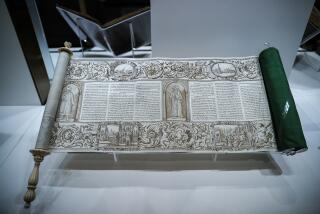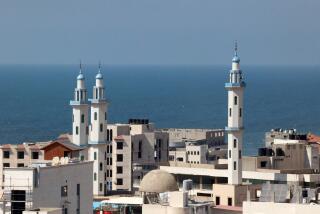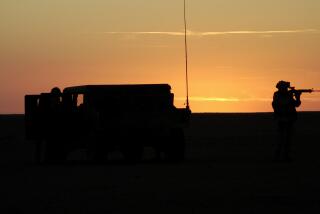Swords into Smart Bombs : The timeless drama of war makes a compelling, if horrific, story. The Gulf War was no exception. : CRUSADE: The Untold Story of the Persian Gulf War, <i> By Rick Atkinson (Houghton Mifflin: $24.95; 523 pp.)</i>
- Share via
The Gulf War has lost its legs.
In the fresh sand of history, the righteousness of the coalition cause seems inflated, the enemy overrated, the domestic sacrifice surprisingly modest. And as the war recedes in time, , Saddam Hussein survives to pursue his taunts and torments.
Within a year of the cease-fire, writes Rick Atkinson, the war became “widely regarded as inconsequential, even slightly ridiculous.”
Still, it was war.
It transfixed much of the world as more than a million humans faced each other under arms in those distant deserts and waterways, putting to trial a trillion dollars worth of Western weapons technology against the combat-hardened, fourth-largest army in the world.
Now, two and a half years later, Atkinson transfixes us again with a crackling-fast, richly reported, absorbing, you-are-there techno-thriller of a military history of this war--a 500-plus pager that you otherwise might be tempted to pass over, but which you will not be tempted to put down.
“Crusade: The Untold Story of the Persian Gulf War” is an astute and sympathetic, although not glorifying, account of this lopsided conflict from a Washington Post reporter who established himself as a military journalist with his 1989 book about West Point, “The Long Gray Line.”
Sympathetic? Indeed, Atkinson writes as a circumspect judge of the battle, but not at all as jury of the larger cause of conflict: For good or ill, the war occurred, and this is an account of it written in the urgent tense of warriors in fighter cockpits, in the bellies of tanks and, most provocatively, in windowless command centers; where a career’s worth of preparation is squeezed into harrowing moments, with life and death swaying in the balance.
Astute? Indeed, Atkinson views the battlefield through field-glasses of history and without the glib arrogance of quickie, revisionist hindsight. Tactical second-guessers are frequently waved off for failing to step into the boots of those who shouldered the responsibility of pressing an air war at speeds of sound and pursuing the largest massed armor engagement in history.
But don’t take me wrong: This is not a rah-rah whitewash. The maddening and petty inefficiencies of interservice rivalry are generously exposed. So are the blunders--some of them so excrucuiatingly avoidable--which resulted in 24% of the U.S. battlefield deaths being attributed to friendly fire. If you have not closely followed all the postwar confessions about the extent and limits of “precision” weaponry, Atkinson draws this into perspective.
And nothing is expounded so richly as the imperfect but headstrong personalties of those who led the war--notably Norman Schwarzkopf, who dominated the campaign and consequently this portrait of it.
News stories in advance of publication and the publisher’s own publicity campaign dwell on Atkinson’s revelations of Schwarzkopf’s incendiary temper and imperial pose.
So painstakingly are these tanrums recounted that the reader’s stomach is apt to tighten every time Schwarzkopf swaggers into the underground Riyadh war room.
But in truth it is not an entirely unflattering portrait that emerges of a general Atkinson compares with other flamboyant field commanders in U.S. history, such as Patton.
“Crusade” describes a Schwarzkopf who routinely and excessively humiliated subordinates and who needed the steady pampering of Colin Powell in Washington; but also a commander who understood the enigmatic character of the Mideast and who embodied what the U.S. military lacked for more than a generation: a fire-breathing warrior-general who inspired Americans at home.
At his television briefings, Schwarzkopf described the planning and execution of the war in the first-person, ego singular, “I.” In the manner of an action novel, “Crusade” brings to the scene and brings to life more than a dozen of the other flag officers, the planners and the field commanders, who pressed the battle through months of preparation and 42 spectacular days of combat.
Also in the fashion of a Tom Clancy potboiler, “Crusade” is paced so as to hurl the reader from one scene to the next. From the war room and the intricacies of air power targeting we leap onto the bridge of a Navy ship, where commanders struggle with computer codes to launch the first missiles of the war. From a cold POW cell in Baghdad, where a prisoner, told George Bush is dead, is interrogated as to whether Dan Quayle will use nuclear weapons, we jump to the White House where Russian efforts almost brought peace when the hammer was dropping on war. Out to the desert of Iraq with the Special Forces, on to Jerusalem where the Israelis pawed the ground, back to Schwarzkopf bawling like an ox into his phone, and so on.
For those who were overwhelmed with the details of reporting from the war during the winter of 1991, Atkinson re-creates a lasting, big-picture understanding of the unfolding battle: the evolving strategy of the air campaign, the preparation and movements of the two Army corps and the Marine and coalition ground troops, the eager actions of the Navy.
With lavish, even juicy, detail, he re-establishes an authentic atmosphere in which America held its breath, first in suspense over whether U.S. arms technology would work, then in wonder at how brutally well it worked. And his book succeeds, like all worthy war literature, as a reminder that electronics and lasers and satellites and gunpowder serve only at the hand of human beings.
Atkinson is a graceful and careful writer, but also one with a fondness--some might find it an excessive fondness--for techno-jargon and the acronyms of the military insider. But this bent toward military-speak also has sharpened his ear for the profane aphorisms and Clausewitzian maximums that warriors collect and share--and which reveal how men steel themselves against the confusion and pressure of combat.
Did I say men ? Yes, regrettably and inexplicably, Atkinson overlooks one of the most compelling and deserving elements of the Gulf War story, the contributions of 41,000 American women who served in uniform in the combat zone. They suffered casualties (15 died); they were taken POW.
Some other things are overlooked in this book, but thankfully so. “Crusade” is not a rehash of how the press covered the war. It not a congested analysis of global politics, nor a memoir of George Bush. It does not overreach by trying to fathom the shifting American mood; nor does it succumb to the fatuous conceit that we are so very much wiser now than then.
Sometimes war happens.
And in the hands of a fine writer, the battle itself makes a horrible and compelling story.
More to Read
Sign up for our Book Club newsletter
Get the latest news, events and more from the Los Angeles Times Book Club, and help us get L.A. reading and talking.
You may occasionally receive promotional content from the Los Angeles Times.






